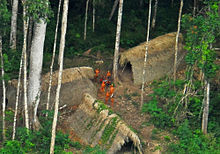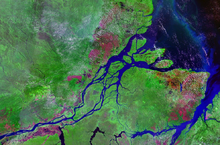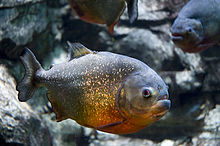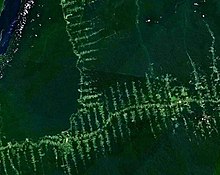The Amazon rainforest is the largest rainforest in the world, covering an area of 5,500,000 km2 (2,100,000 sq mi). It represents over half of the planet's remaining rainforests, and comprises the largest and most biodiverse tract of tropical rainforest in the world. This region includes territory belonging to nine nations. The majority of the forest is contained within Brazil, with 60%, followed by Peru with 13%, Colombia with 10%, and with minor amounts in Venezuela, Ecuador, Bolivia, Guyana, Suriname and France (French Guiana).
The cattle sector of the Brazilian Amazon, incentivized by the international beef and leather trades, has been responsible for about 80% of all deforestation in the region, or about 14% of the world's total annual deforestation, making it the world's largest single driver of deforestation. By 1995, 70% of formerly forested land in the Amazon, and 91% of land deforested since 1970, had been converted to cattle ranching. Much of the remaining deforestation within the Amazon has resulted from farmers clearing land for small-scale subsistence agriculture or mechanized cropland producing soy, palm, and other crops.
More than one-third of the Amazon forest belongs to over than 3,344 formally acknowledged indigenous territories. Until 2015, only eight percent of Amazonian deforestation occurred in forests inhabited by indigenous peoples, while 88% of occurred in the less than 50% of the Amazon area that is neither indigenous territory nor protected area. Historically, the livelihoods of indigenous Amazonian peoples have depended on the forest for food, shelter, water, fibre, fuel and medicines. The forest is also interconnected with their identity and cosmology. For this reason the deforestation rates are lower in indigenous territories, despite pressures encouraging deforestation being stronger.
According to 2018 satellite data compiled by a deforestation monitoring program called Prodes, deforestation has hit its highest rate in a decade. About 7,900 sq km (3,050 sq miles) of the rainforest was destroyed between August 2017 and July 2018. Most of the deforestation occurred in the states of Mato Grosso and Pará. The BBC reported the environment minister, Edson Duarte, as saying illegal logging was to blame, but critics suggest expanding agriculture is also encroaching on the rainforest. It is suggested that at some point the forest will reach a tipping point, where it will no longer be able to produce enough rainfall to sustain itself.
History
In the pre-Columbian era,
parts of the Amazon rainforest were a densely populated open
agriculture. After the European colonization in the 16th century, with
the hunt for gold, Western diseases, slavery and later the rubber boom, the Amazon rainforest was depopulated and the forest grew larger.
Prior to the 1970s, access to the forest's largely roadless
interior was difficult, and aside from partial clearing along rivers the
forest remained intact. Deforestation accelerated greatly following the opening of highways deep into the forest, such as the Trans-Amazonian highway in 1972.
In parts of the Amazon, the poor soil made plantation-based
agriculture unprofitable. The key turning point in deforestation of the
Brazilian Amazon was when colonists began to establish farms within the
forest during the 1960s. Their farming system was based on crop
cultivation and the slash-and-burn method. However, the colonists were unable to successfully manage their fields and the crops due to the loss of soil fertility and weed invasion due to this method.
In indigenous areas of the Peruvian Amazon, such as the Urarina's Chambira River Basin,
the soils are productive for only relatively short periods of time,
therefore causing indigenous horticulturalists like the Urarina to move
to new areas and clear more and more land.
Amazonian colonization was ruled by cattle raising because ranching
required little labor, generated decent profits, and land under state
ownership to private companies, without term limits on the property
rights.
While the law was promoted as a "reforestation" measure, critics
claimed the privatization measure would in fact encourage further
deforestation of the Amazon, while surrendering the nation's rights over natural resources to foreign investors and leaving uncertain the fate of Peru's indigenous people, who do not typically hold formal title to the forestlands on which they subsist. Law 840 met widespread resistance and was eventually repealed by Peru's legislature for being unconstitutional.
In 2015 illegal deforestation of the Amazon was on the rise again
for the first time in decades, this was largely a result of consumer
demand for products like palm oil. As consumer pressure increases, Brazilian farmers clear their land to make more space for crops like palm oil, and soy
Also, studies done by Greenpeace showed that 300 billion tons of
carbon, 40 times the annual greenhouse gas emissions from fossil fuels,
are stored in trees.
In addition to the carbon release associated with deforestation, NASA
has estimated that if deforestation levels proceed, the remaining worlds
forests will disappear in about 100 years. The Brazilian government adopted a program called RED (United Nations Reducing emissions from deforestation and forest degradation Program) in order to help prevent deforestation.
The RED program has helped more than 44 countries across Africa with
the development of education programs and has donated more than 117
million to the program.
As of January 2019, the president of Brazil – Jair Bolsonaro –
has made an executive order that allows the agriculture ministry to
oversee some of the land in the Amazon.
Cattle ranchers and mining companies favor the president’s decision.
The Brazilian economic policy is influencing the government to condone
development on tribal territory in order to accumulate exports and
increase economic growth. That has been criticized because taking away
tribal land will endanger the indigenous people that live there now. The
deforestation of the Amazon leads the acceleration of climate change.
Causes of deforestation
Fires, and deforestation in Rondônia
One consequence of forest clearing in the Amazon: thick smoke that hangs over the forest
Deforestation of the Amazon rainforest can be attributed to many
different factors at local, national, and international levels. The
rainforest is seen as a resource for cattle pasture, valuable hardwoods,
housing space, farming space (especially for soybeans), road works
(such as highways and smaller roads), medicines and human gain. Trees
are usually cut down illegally.
A 2009 Greenpeace report found that the cattle sector in the Brazilian Amazon, supported by the international beef and leather trades, was responsible for about 80% of all deforestation in the region, or about 14% of the world's total annual deforestation, making it the largest single driver of deforestation in the world. According to a 2006 report by the Food and Agriculture Organization of the United Nations, 70% of formerly forested land in the Amazon, and 91% of land deforested since 1970, is used for livestock pasture.
Additional deforestation in the Amazon has resulted from farmers clearing land for small-scale subsistence agriculture or for mechanized cropland. Scientists using NASA
satellite data found in 2006 that clearing for mechanized cropland had
become a significant force in Brazilian Amazon deforestation. This
change in land use may alter the region's climate. Researchers found
that in 2004, a peak year of deforestation, more than 20 percent of the Mato Grosso state's forests were converted to cropland.
In 2005, soybean prices fell by more than 25 percent and some areas of
Mato Grosso showed a decrease in large deforestation events, suggesting
that the rise and fall of prices for other crops, beef and timber may
also have a significant impact on future land use in the region.
Until 2006, a major driver of forest loss in the Amazon was the cultivation of soy, mainly for export and production of biodiesel and animal feed; as soybean prices have risen, soy farmers pushed northwards into forested areas of the Amazon.
However, a private sector agreement referred to as the Soy Moratorium
has helped drastically reduce the deforestation linked to soy production
in the region. In 2006, a number of major commodity trading companies
such as Cargill
agreed to not purchase soybeans produced in the Brazilian Amazon in
recently deforested areas. Before the moratorium, 30 percent of soy
field expansion had occurred through deforestation, contributing to
record deforestation rates. After eight years of the moratorium, a 2015
study found that although soy production area had expanded another 1.3
million hectares, only about 1 percent of the new soy expansion had come
at the expense of forest. In response to the moratorium, farmers were
choosing to plant on already cleared land.
The needs of soy farmers have been used to validate some controversial
transportation projects that have developed in the Amazon. The first two highways, the Belém-Brasília (1958) and the Cuiaba-Porto Velho (1968), were the only federal highways in the Legal Amazon
to be paved and passable year-round before the late 1990s. These two
highways are said to be "at the heart of the 'arc of deforestation'",
which at present is the focal point area of deforestation in the
Brazilian Amazon. The Belém-Brasília highway attracted nearly two
million settlers in the first twenty years. The success of the
Belém-Brasília highway in opening up the forest was reenacted as paved
roads continued to be developed, unleashing the irrepressible spread of
settlement. The completion of the roads was followed by a wave of
resettlement; these settlers had a significant effect on the forest as
well.
Research conducted by Leydimere Oliveira et al. has shown that
the more rainforest is logged in the Amazon, the less precipitation
reaches the area and so the lower the yield per hectare becomes. Thus
for Brazil as a whole, there is no economic gain to be made by logging
and selling trees and using the logged land for pastoral purposes.
A September 2016 Amazon Watch
report concludes that imports of crude oil by the US are driving
rainforest destruction in the Amazon and releasing significant
greenhouse gases.
Forest loss rates
The annual rate of deforestation in the Amazon region dramatically increased from 1991 to 2003. In the nine years from 1991 to 2000, the total area of Amazon rainforest cleared since 1970 rose from 419,010 to 575,903 km2 (161,781 to 222,357 sq mi), comparable to the land area of Spain, Madagascar or Manitoba. Most of this lost forest was replaced by pasture for cattle.
Deforestation of the Amazon rainforest continued to accelerate in
the early 2000s, reaching an annual rate of 27,423 km² of forest loss
in the year 2004. Today the remaining forest cover
continues to dwindle, though the annual rate of forest loss has
generally been slowing since 2004. However, rates of deforestation
jumped again in 2008, 2013 and 2015.
Between August 2017 and July 2018, 7,900 square kilometres
(3,100 sq mi) were deforested in Brazil – a 13.7% rise over the previous
year and the largest area cleared since 2008. Deforestation in the Brazilian Amazon rainforest rose more than 88% in June 2019 compared with the same month in 2018.
| Period | Estimated remaining forest cover in the Brazilian Amazon (km²) |
Annual forest loss (km²) |
Percent of 1970 cover remaining |
Total forest loss since 1970 (km²) |
|---|---|---|---|---|
| Pre–1970 | 4,100,000 | — | — | — |
| 1977 | 3,955,870 | 21,130 | 96.5% | 144,130 |
| 1978–1987 | 3,744,570 | 21,130 | 91.3% | 355,430 |
| 1988 | 3,723,520 | 21,050 | 90.8% | 376,480 |
| 1989 | 3,705,750 | 17,770 | 90.4% | 394,250 |
| 1990 | 3,692,020 | 13,730 | 90.0% | 407,980 |
| 1991 | 3,680,990 | 11,030 | 89.8% | 419,010 |
| 1992 | 3,667,204 | 13,786 | 89.4% | 432,796 |
| 1993 | 3,652,308 | 14,896 | 89.1% | 447,692 |
| 1994 | 3,637,412 | 14,896 | 88.7% | 462,588 |
| 1995 | 3,608,353 | 29,059 | 88.0% | 491,647 |
| 1996 | 3,590,192 | 18,161 | 87.6% | 509,808 |
| 1997 | 3,576,965 | 13,227 | 87.2% | 523,035 |
| 1998 | 3,559,582 | 17,383 | 86.8% | 540,418 |
| 1999 | 3,542,323 | 17,259 | 86.4% | 557,677 |
| 2000 | 3,524,097 | 18,226 | 86.0% | 575,903 |
| 2001 | 3,505,932 | 18,165 | 85.5% | 594,068 |
| 2002 | 3,484,281 | 21,651 | 85.0% | 615,719 |
| 2003 | 3,458,885 | 25,396 | 84.4% | 641,115 |
| 2004 | 3,431,113 | 27,772 | 83.7% | 668,887 |
| 2005 | 3,412,099 | 19,014 | 83.2% | 687,901 |
| 2006 | 3,397,814 | 14,285 | 82.9% | 702,186 |
| 2007 | 3,386,163 | 11,651 | 82.6% | 713,837 |
| 2008 | 3,373,252 | 12,911 | 82.3% | 726,748 |
| 2009 | 3,365,788 | 7,464 | 82.1% | 734,212 |
| 2010 | 3,358,788 | 7,000 | 81.9% | 741,212 |
| 2011 | 3,352,370 | 6,418 | 81.8% | 747,630 |
| 2012 | 3,347,799 | 4,571 | 81.7% | 752,201 |
| 2013 | 3,341,908 | 5,891 | 81.5% | 758,092 |
| 2014 | 3,336,896 | 5,012 | 81.4% | 763,104 |
| 2015 | 3,330,689 | 6,207 | 81.2% | 769,311 |
| 2016 | 3,322,796 | 7,893 | 81.0% | 777,204 |
| 2017 | 3,315,849 | 6,947 | 80.9% | 784,151 |
| 2018 | 3,307,949 | 7,900 | 80.7% | 792,051 |
In Brazil, the Instituto Nacional de Pesquisas Espaciais
(INPE, or National Institute of Space Research) produces deforestation
figures annually. Their deforestation estimates are derived from 100 to
220 images taken during the dry season in the Amazon by the Landsat satellite, and may only consider the loss of the Amazon rainforest – not the loss of natural fields or savannah within the Amazon biome.
Impacts
Deforestation
and loss of biodiversity have led to high risks of irreversible changes
to the Amazon's tropical forests. It has been suggested by modeling
studies that the deforestation may be approaching a "tipping point", after which large-scale "savannization"
or desertification of the Amazon will take place, with catastrophic
consequences for the world's climate, due to a self-perpetuating
collapse of the region's biodiversity and ecosystems.
Research suggests this tipping point will be reached at about 20-25%
deforestation (hence 3% to 8% more than the 17% deforestation already
reached in 2018).
Since the 17% deforestation has been reached in a period of just 50
years, it is clear that we are very near to this "point of no return".
Impacts on water supply
The
deforestation of the Amazon rainforest has had a significant negative
impact on Brazil's freshwater supply, harming, among others, the agricultural industry that has contributed to the clearing of the forests. In 2005, parts of
the Amazon basin experienced the worst drought in more than a century. This has been the result of two factors:
- The rainforest provides much of the rainfall in Brazil, even in areas far from it. Deforestation increased the impacts of the droughts of 2005, 2010, and 2015-2016.
- The rainforest, by inducing rainfall and helping with water storage, provides freshwater to the rivers that give water to Brazil and other countries.
Impact on local temperature
In
2019, a group of scientists published research suggesting that in a
"business as usual" scenario, the deforestation of the Amazon rainforest
will raise the temperature in Brazil by 1.45 degrees. They wrote:
"Increased temperatures in already hot locations may increase human mortality rates and electricity demands, reduce agricultural yields and water resources, and contribute to biodiversity collapse,
particularly in tropical regions. Furthermore, local warming may cause
shifts in species distributions, including for species involved in infectious disease transmissions." The authors of the paper say that deforestation is already causing a rise in the temperature.
Impact on indigenous people
Members of an uncontacted tribe encountered in the Brazilian state of Acre in 2009
More than one third of the Amazon forest belongs to over 3,344
formally acknowledged Indigenous Territories. Until 2015, only eight
percent of Amazonian deforestation occurred in forests inhabited by
indigenous peoples, while 88% of occurred in the less than 50% of the
Amazon area that is neither indigenous territory nor protected area.
Historically, the livelihoods of indigenous Amazonian peoples have
depended on the forest for food, shelter, water, fibre, fuel and
medicines. The forest is also interconnected with their identity and
cosmology. For this reason, the deforestation rates are lower in
Indigenous Territories, despite pressures encouraging deforestation
being stronger.
The native tribes of the Amazon have often been abused during the
Amazon's deforestation. Loggers have killed natives and encroached onto
their land. Many uncontacted peoples have come out of the jungles to mingle with mainstream society after threats from outsiders. Uncontacted peoples making first contact
with outsiders are susceptible to diseases to which they have little
immunity. Tribes can easily be decimated; the resulting deaths have been
compared to a genocide.
For many years, there has been a battle to conquer the
territories that indigenous people live on in the Amazon, primarily from
the Brazilian government. The demand for this land has originated
partly from a desire to improve Brazil's economic status. Many people,
including ranchers and land swindlers from the southeast, have wanted to
claim the land for their own financial gain. As of the beginning of
2019, the new president of Brazil, Jair Bolsonaro,
has made an executive order that permits the agriculture ministry to
regulate the land that tribal members inhabit in the Amazon. This act is
essentially declaring war on the indigenous people in the fight for
their territory.
In the past, mining locations were allowed to be constructed in
the territory of an isolated tribal group called Yanomami. Because of
the conditions that these indigenous people were subjected to, many of
them developed health problems, including tuberculosis.
If their land is used for new development, many of the tribal groups
will be forced out of their homes and many may die. On top of the
mistreatment of these people, the forest itself will be taken advantage
of and many of the indigenous peoples' resources for daily life will be
stripped from them.
Future of the Amazon rainforest
Using the 2005 deforestation rates, it was estimated that the Amazon rainforest would be reduced by 40% in two decades.
The rate of deforestation is now slowing; rates of forest loss in 2012
were the slowest on record. However, the forest is still shrinking.
Norwegian prime minister Jens Stoltenberg
announced on September 16, 2008, that Norway's government would donate
US $1 billion to the newly established Amazon fund. The money from this
fund would go to projects aimed at slowing down the deforestation of the
Amazon rainforest.
In September 2015, Brazilian president Dilma Rousseff
told the United Nations that Brazil had effectively reduced the rate of
deforestation in the Amazon by 82 percent. She also announced that over
the next 15 years, Brazil aimed to eliminate illegal deforestation,
restore and reforest 120,000 km2 (46,000 sq mi), and recover 150,000 km2 (58,000 sq mi) of degraded pastures.
In August 2017, Brazilian president Michel Temer abolished an Amazonian nature reserve the size of Denmark in Brazil's northern states of Pará and Amapá.
In April 2019, a court in Ecuador stopped oil exploration activities in 1,800 square kilometres (690 sq mi) of the Amazon rainforest.













